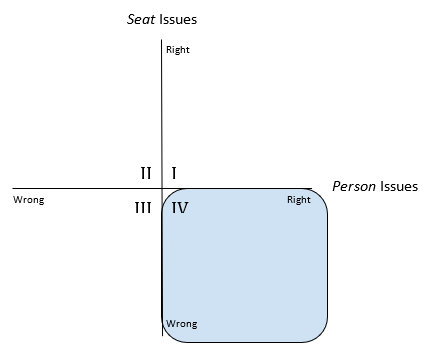People management can be one of the biggest challenges that comes with running a firm. As the firm grows, its needs change. Sometimes, restructuring your firm is the only option to continue growing or best serve clients.
Restructuring your firm need not cause excessive stress, though it may seem daunting at first.
Gino Wickman and Rene Boer, authors of How to Be a Great Boss, state that there are four ways to assess employee disengagement:
- Right person, right seat
- Wrong person, right seat
- Wrong person, wrong seat
- Right person, wrong seat
I put this in a matrix so I can help my consulting clients understand the team issues they are facing:

Right Person, Wrong Seat
In this article, I want to focus on the fourth quadrant, the Right Person, Wrong Seat scenario. This is a team member that is a good fit with your team, adheres to the mission, and truly lives by the core values of the firm most of the time. But you may find them hurting the firm by holding back the work, becoming a bottleneck, or struggling to do the work that is required of their role.
When this situation happens, the first thing to do is to look at your leadership style. Role clarity is vital to team success. Ask yourself if you’ve been clear about the role that the person is trying to perform. Do they know what is expected of them? Is this wrong seat issue due to their lack of understanding around what is required in this role? Maybe you didn’t hire well, or maybe you merged recently and team members you didn’t know much about got plugged into roles they were not suited for.
A right person is someone you want to fight for in your firm! They are so hard to come by that you want to do whatever you can within reason to help them perform better. So a look at yourself and how you lead is the first place to start.
Restructuring Your Firm
The second step you could take would be to conduct a restructure of your firm. This sounds like a huge undertaking, but it really can be as big or as small an effort as you need. A restructure is as simple as ‘moving your org chart around.’ Similar to the 4 quadrant issues mentioned at the beginning of this article, a restructure can involve:
- Undertaking growth training to support someone in the right person, right seat quadrant
- Seeking to rehabilitate someone with a Performance Improvement Plan (PIP) in the wrong person, right seat quadrant
- Removing someone from the team and replacing them if they are in the wrong person, wrong seat quadrant, and
- Promoting or creating new seats in the org chart if they are in the right person, wrong seat quadrant
From our own personal experience in growing our firm, #4 above can be an underused method to enhance the value your team can deliver clients. Many firm leaders feel locked into what they see in their org chart. And they respond with blinders on when building their team. This can happen when firms simply replace one team member with another identical team member in the same role. However, creating a brand-new role can be one of the most fun and creative aspects to team building.
If you have someone that is a great team member, but just not excelling at the role they are in, or recently put in or promoted to, then you can take some of their greatest gifts and consider creating a role just for them. To do this, you will often ‘package up’ the various parts of a few different roles in the firm, redefine what the other team members do, and then place a list of new role requirements into this newly crafted role. We do this once or twice a year in our firm. As we grow, we will typically need new unanticipated roles at one level of growth that we didn’t realize we needed. As you grow your firm, you can’t see the future, so you will more than likely have to create a new role in the future to accommodate your team’s growth and abilities.
One of the best results of a firm restructure is the new gift of unlocked value that you bring your clients. With a new role comes newly minted deliverable value. You can often sell new things after creating a new role because the value created by that role becomes a new service with a price. Make sure that when you invest in a restructure, you get the value back by crafting some new services or attempting to sell new things you’ve never sold before. Then you get the monetary payback of the work you’ve done to restructure your firm, and help team members grow to their fullest potential.
Do you embody the future CPA?
Building the accounting firm of the future starts with changing your mindset. Your clients and your prospects expect more from you. Reform your accounting business to exceed those expectations. Take the first step by reading our new white paper, The Future CPA: Make Your Practice The Accounting Firm of the Future. You’ll learn about the seismic changes affecting your profession, along with a roadmap to help you navigate them.











